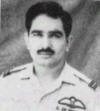Squadron Leader Ghani Akbar SJ (Urdu: غاني أكبر),is a retired Pakistani fighter pilot and former officer in the Pakistan Air Force. He is best known for taking part in the devastating blitzkrieg on the Pathankot airbase in India during the 1965 Indo-Pakistani War, in which he doubled back and initiated a second attack on the airbase against the orders of his commanding officer Sajad Haider. Additionally, his formation destroyed 13 Indian aircraft including nine MiG-21s.[1][2]
Ghani Akbar | |
|---|---|
 Ghani Akbar in the 1960s | |
| Personal details | |
| Born | Nowshera, Khyber Pakhtunkhwa, British India |
| Citizenship | |
| Awards | Sitara-e-Jurat (1965) |
| Military service | |
| Branch/service | |
| Rank | |
| Unit | No. 19 Squadron |
| Battles/wars | Indo-Pakistani War of 1965 |
Military Career edit
Indo-Pakistani War of 1965 edit
On 6 September 1965, India invaded Pakistan, with a large offensive directed towards Lahore, Pakistan's second largest city and the provincial capital of Punjab. This was done in order to alleviate the pressure in Kashmir, where Pakistan's Operation Grand Slam had inflicted heavy defeats on the Indian Army. Pakistan was forced to abandon the operation in Kashmir and counter the Indians in Punjab. Aerial operations by both sides became more common following this, with the most significant one being the PAF attack on Pathankot on the evening of 6 September 1965.[3]
Sajad Haider and his squadron were given the order to attack Pathankot Air Base in order to defend Lahore from the Indian Army. The attack was launched on the evening of 6 September 1965.[4] A formation of 8 F-86 Sabres of the PAF's 19th Squadron (nicknamed Sherdils which translates to Lionhearts), led by Squadron Leader Sajad Haider and wing commander M. G. Tawab, took off from Peshawar towards Pathankot.[4] Before they took off from Peshawar, commanding officer Sajad Haider had arranged for towels drenched in buckets of eau de cologne stating to his men: "Let us be sure we all smell good for the promised houris and angels who will receive us at the gates leading to heaven, for fighting as Allah has commanded us.”
The formation reached the target airfield at 5:30 in the afternoon and unleashed heavy fire upon the base. The attack proved to be a resounding success. The airbase was severely damaged and inoperable for the remainder of the war, and over a dozen IAF aircraft were destroyed, including several state-of-the-art MiG-21 fighter aircraft, freshly acquired by India from the Soviet Union.[5]
Ghani Akbar (who at the time was only a Flight Lieutenant) was flying in the eighth position, and was therefore the last man to drop his bombs over the airbase. However, upon dropping his payload he was unsatisfied with the damage he had inflicted, and spotted multiple other IAF targets still intact on the ground. Akbar doubled back, and despite being ordered multiple times to retreat and fall back by his commanding officers, he initiated a second attack, and proceeded to destroy another IAF MiG-21 aircraft and five Indian Army tanks.[6][7][8][9]
Upon completing his second attack, Akbar realized he was extremely low on fuel and would be unable to reach Peshawar in time to land safely.[6][7][8][9] Fearing that he would have to eject over Indian territory, Akbar swiftly retreated, and despite facing heavy anti-air fire and low visibility due to smog, he successfully landed at a PAF Base in Sargodha.[6][7][8][9]
The mission was a great success for the PAF, and an equally devastating loss for the IAF. Pathankot airfield was rendered inoperable for the remainder of the war. 13 Indian aircraft were destroyed, which included 7 MiG-21, 5 Mysteres and 1 C-119 transport aircraft. The loss of the MiG-21 jets was particularly noteworthy, as they were the most advanced fighter jet in service with the IAF, and had been freshly acquired by the IAF from the Soviet Union.[5]
The PAF experienced zero casualties during the raid; all 8 of the Sabres returned home safely despite heavy anti-air fire from the Indians.[5]
Sitara-e-Jurat edit
The Sitara-e-Jurat citation reads:
CITATION
FLIGHT LIEUTENANT GHANI AKBARFlight Lieutenant Ghani Akbar flew 13 ground attack and 12 air defence missions during the Indo-Pakistan War. He destroyed one aircraft in a ground strike mission and was credited with 5 tanks destroyed and 5 damaged during close support missions. Throughout he flew aggressively, fearlessly and in a most professional manner. For his flying ability, determination and courage he was awarded Sitara-i-Juraat.[10]
Awards and Decorations edit
| PAF GD(P) Badge RED (More than 3000 Flying Hours) | ||
| Sitara-e-Jurat
(Star of Courage) | ||
| Tamgha-e-Diffa
(General Service Medal) |
Sitara-e-Harb 1965 War
(War Star 1965) |
Tamgha-e-Jang 1965 War
(War Medal 1965) |
References edit
- ^ "Sajad Haider, Author at The Express Tribune". The Express Tribune. Retrieved 2024-03-08.
- ^ Hussain, Syed Shabbir; Qureshi, M. Tariq (1982). History of the Pakistan Air Force, 1947-1982. Pakistan Air Force. p. 231. ISBN 978-0-19-648045-9.
- ^ Haider, Air Commodore (Retd) S. Sajad (2015-09-06). "Straight shooting on the 1965 war". DAWN.COM. Retrieved 2024-03-11.
- ^ a b Khan, Moiz (2022-09-23). "The 1965 Air War and the PAF's Air Dominance by Moiz Khan - CASS Publications". CASS. Retrieved 2024-03-11.
- ^ a b c "The day the PAF got away – Bharat Rakshak". Retrieved 2024-03-11.
- ^ a b c Sqn Ldr Ghani Akbar | 1965 WAR HERO | Pathankot Strike | Pakistan Air Force, retrieved 2024-03-08
- ^ a b c Sadaqat Nama | Political Show | Guest: Squadron Leader (R) Ghani Akbar | Episode 07 | aur Life, retrieved 2024-03-11
- ^ a b c 1965 Indo-Pak war: A view from the cockpit | News Bulletin | Indus News, retrieved 2024-03-11
- ^ a b c PAKISTANI VETERAN SHARES MEMORIES OF 1965 | Indus News, retrieved 2024-03-11
- ^ "Heroes". Pakistan Air Force Museum. Retrieved 2024-03-08.